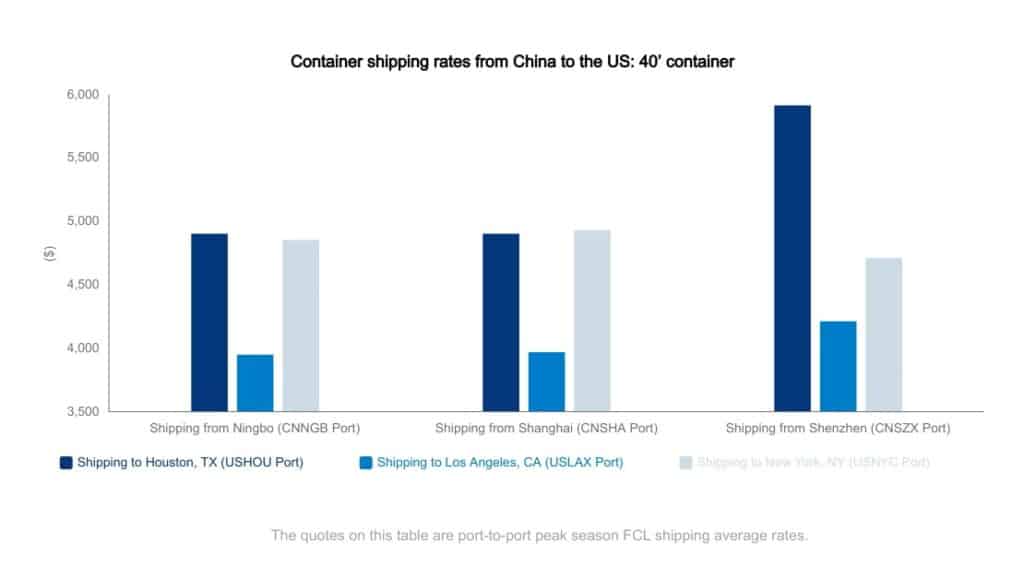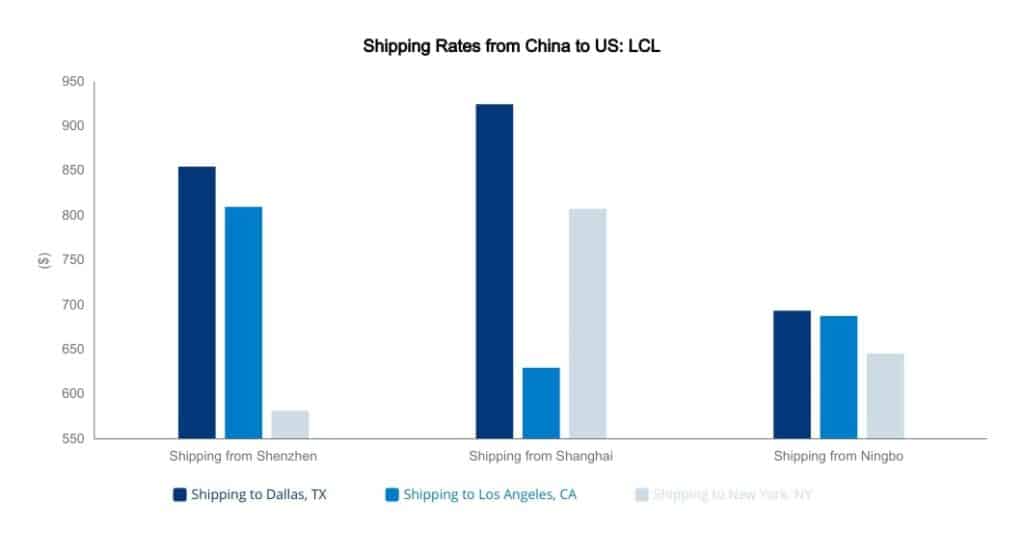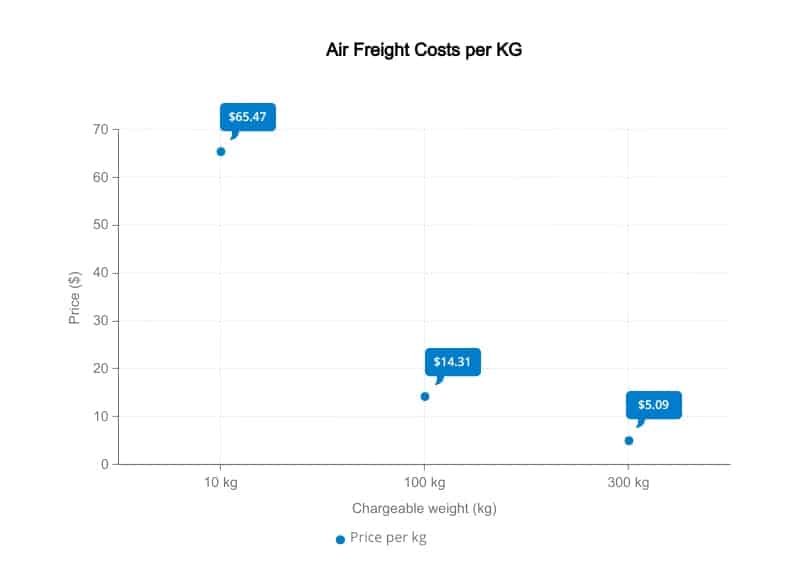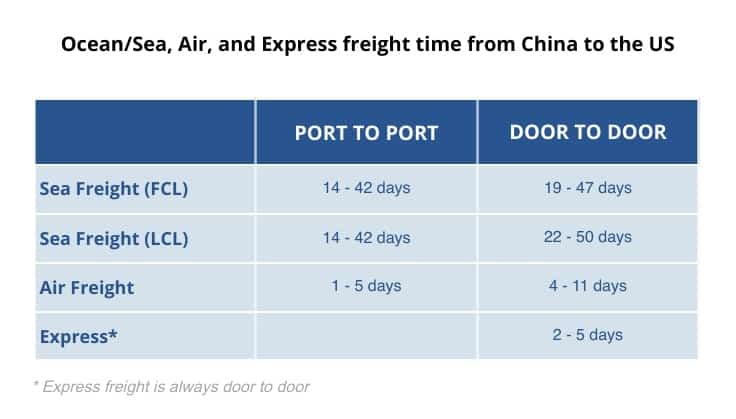Shipping Cost from China to the US
Freight rates determine how much it will cost to transport cargo from one point to another. The rate is determined by the type of goods being shipped, the mode of transport, the dimensional weight of the cargo, and the distance to the delivery destination.
This graphic guide to freight rates from China to US leverages advanced data from a variety of real time sources to give you a better understanding of what it costs to get your goods from China to the US.
Other factors impacting freight rates include seasonality, current events (ahem…COVID-19), and capacity.
Ocean Freight from China to the US
Ocean Freight FCL
FCL, or full container load, means your goods fill an entire container, either 20’ or 40’ long. If you are shipping at a high volume, you’ll save time and money by shipping FCL. Pricing for FCL is done as a flat rate, regardless of whether or not your container is completely full.
Learn more about FCL here.

Ready to ship from China to the US?
Access live instant freight quotes
Ocean Freight LCL
LCL, or less than a container load, means your goods do not fill an entire container, and will be shipped along with other boxes or pallets. Note that when you ship LCL, your goods will need to be consolidated at the origin port and deconsolidated at the destination port.
That’s why LCL shipping takes a few days longer than FCL.

Air Freight from China to the US
Air cargo shipping cost from China to USA per kg
Shipping by air is generally faster but more expensive than shipping by ocean, so the mode you choose will depend on the size and weight of your shipment, and how quickly you need it to arrive at destination.
For help choosing which mode is right for your shipment, use our air vs. ocean comparison calculator.

Shipping from China to USA transit time
Ocean, Air and Express freight transit time from China to the US
How long will it take to ship from China to US?
Your shipment’s transit time will be impacted by location, shipment size, and season. Transit times aren’t always the same. Depending on market conditions, acts of nature, and other occurrences, freight shipments may be delayed.
Use the following table for timing estimates for each shipping mode from China to the US.

How much is shipping from China to the US?
International freight quote calculator & freight rate estimates for shipping goods by ocean, air, and truck
Get an estimate from the world’s largest database of freight rates with our freight calculator and then
join Freightos.com to compare, book, and manage your upcoming shipments.
Are you ready to book?
Just click the button to access live freight quotes from global logistics providers.
China to US shipping delays: are shipments from China delayed?
For shippers from China to the US, the coronavirus has been profoundly disruptive, causing major delays to both manufacturing and shipping.
Production in China is back to normal, but COVID-19’s impact is creating a variety of other challenges including high demand and delays at US ports and warehouses.
Additionally, restrictions on air travel can dramatically reduced air freight capacity, leaving space tight and prices volatile.
For the latest developments visit the Freightos.com updates page.
Top shipping routes from China to the US
When you’re shipping from China to the US, there are many different viable routes that you might want to ship.
Freightos has global shipping rates for all of these lanes and can provide real-time FCL, LCL & Air rates for shipping from China to the US.
The top 3 shipping lanes for shipping freight from China to the US are:
- Shipping from Shanghai to New York
- Shipping from Shanghai to Los Angeles
- Shipping from Shenzhen to Los Angeles
Get an estimate from the world’s largest database of freight rates and then join Freightos.com to compare, book, and manage your upcoming shipments.
Cheapest shipping from China to the US?
Often the most important freight factor when shipping from China is cost.
Shipping Small Packages from China
If you’re importing small goods, like a new product sample, freight shipping is overkill. It will cost you more and take you longer. You’re safer falling back on:
Regular Post
Mail may be the most economical shipping option for small shipments of light and small products. For example, China Post offers several mail options: Air Mail/SAL or Surface Mail for small parcels; Air Parcel, SAL or Surface Mail for large packages; and the EMS/China International Express and EUB priority systems for packages.
But carefully check each option out first and then compare it with courier charges. The heavier the parcel, the more likely it is that a courier (express freight) will be cheaper. While mail will run cheap, you’re also looking at a long wait time.
Express Shipping from China to the US
Using an international courier, also known as express freight is generally more reliable and quicker than by mail, whether it’s DHL, UPS or TNT.
As a rule of thumb, at about $5 per kilo, express freight is the cheapest shipping mode for packages or small shipments up to about 150 kg. But watch out, some couriers will charge an astronomical amount if you are not a registered customer.
Shipping from China to USA pricing
Air freight costs and rates from China to the US
At about $3 per kilo, standard air freight is the cheapest option for shipments between about 150 kilos and 500 kg. Very light shipments for their size might be charged on dimensional weight, rather than actual weight.
Air freight by far the fastest. Express air freight is a little more expensive. Freight rates can vary widely between freight forwarders and prices change regularly, so make sure you shop around.
For larger shipments sizes and origin/destination pairs, LCL (less than container load) ocean freight costs might actually be cheaper than air freight costs – make sure you check it out!
Sea freight costs and rates from China to the US
Once a shipment weighs more than around 500 kg, sea freight becomes the cheapest option. Ocean freight offers tremendous economies of scale (some ships can carry 20,000 twenty-foot containers).
Some freight forwarders offer a premium service, often called expedited freight, which is a little more expensive than normal ocean freight. Like air freight, ocean freight rates vary widely between forwarders, and over time, so again – shop around.
You can even start shopping around right now with our handy freight rate calculator. It will give you instant shipping estimates for both air and sea.
How can Air Freight be cheaper than Sea Freight?
Each shipping mode has its own combination of base and variable costs. Modes with a lower base cost are cheaper for smaller shipments while modes with lower variable weight costs are the cheaper options for larger shipments, even if they start out with a high base cost.
How long does it take to ship from China to the USA?
Rules of thumbs for lead times (in regular conditions) are 1-2 weeks for regular post, 3 days for air express freight, 8-10 days for air freight, and 30-40 days for ocean freight.
These estimates can be affected by a wide range of circumstances, so it’s worth checking with your logistics provider.
Regular Post
Shipping from China by surface mail takes forever. China Post offers much quicker, cost-effective options in airmail and express mail service (EMS), which are both likely to take between one and two weeks.
US Customs will deprioritize release of parcels if something looks wrong with the paperwork. So, increase your chances of regular post only taking one week, by checking that the supplier gets the paperwork right before sending.
Express Shipping Options
When shipping from China by international courier, allow three days. That includes either picking the parcel up at the Chinese supplier’s door unless the supplier has dropped it off at their depot. If it’s really urgent, there are more expensive premium services which may even be delivered overnight.
Air Freight
Standard air freight between China and the US generally takes around 8-10 days. It’s not that planes are slower; it comes down to the fact that air freight processes are more complicated than for express freight. Express air freight services typically shaves 2-3 days off standard air freight transit times.
Sea Freight
At around 30-40 days for a door to door shipment from China to the USA, sea freight has the longest lead time. That’s because ships move a lot slower than planes.
Beyond additional preparation required, ocean liners have also started to move slower to save fuel (and money). For instance, US Customs requires importers using a single entry bond and traveling by sea freight to also take out an ISF bond.
On top of that, port congestion, customs delays, and bad weather condition affects sea freight more than they do for air freight.
Sea freight offers a premium service if you need your goods to move faster. Depending on shipment requirements, expedited freight might be able to really cut down the transit time. In some instances, it might even be competitive with air freight lead times.
Expedited freight works by streamlining sea freight processes and by only tying in with the faster sea services and premium trucking services. This makes expedited freight a great option when shipping from China.
More on Shipping Modes from China to the US
As important as cost and speed is when shipping from China, you should also be aware of some key details and differences between various modes.
Regular Post
Shipping small packages of samples might be cost-effective by regular post. Also, importers just getting started might consider this mode to mail directly from the factory to the customer – essentially drop shipping.
This process can be set up quickly and avoids having to make an early outlay for warehousing costs. But from a cost perspective, you’re going to want to rethink your strategy when sales volumes start to pick up.
Express Shipping from China to the US
The two big US domestic couriers, FedEx and UPS, are also popular choices for China-US deliveries. So too are other major international couriers like DHL and TNT.
Like mail, the process is simple: it’s generally straightforward to find the rates online, and there’s no need for a formal quote. And like the other mode options, most courier companies provide air express shipping options. US customs applies if the value of the goods is over $800, but clearing customs is a lot more straightforward than with air freight or ocean freight.
Importers planning on buying large quantities of stock and using sea or air freight, should still arrange a trial shipment by courier before signing a big contract with a supplier. This way tests the waters with product sales. It also helps estimate profitability: the cost of this shipment being an upper limit for ongoing freight costs.
Air Freight from China to the US
The larger the shipment, the more complex the shipping process. There’s more to finding space in a plane’s hold than with regular courier services. And shipments are delivered to a facility where they are consolidated (packed with other shipments) first.
This process is repeated in reverse at the other end. The US customs process is a also lot more complicated than for express freight.
International law, national law, carrier organization regulations and individual carrier regulations all play their part in defining and restricting what goods are considered dangerous for transport.
Generally, more products restricted as air cargo than ocean cargo, including: gases (e.g. lamp bulbs), all things flammable (e.g. perfume, Samsung Galaxy Note 7), toxic or corrosive items (e.g. batteries), magnetic substances (e.g. speakers), oxidizers and biochemical products (e.g. chemical medicines), and public health risks (e.g. untanned hides).
For further information on shipping hazardous material, check out the Freightos Hazardous Material Table.
FCL and LCL Shipping from China to the US
Ocean freight usually means containers. But if you don’t have enough material to fill a full 20’ or 40’ container’s worth of shipment (FCL), it’s usually worthwhile to ship a less-than-container load (LCL).
With LCL, several shipments are consolidated and packed into one container. This means more work for the forwarder, and not just the physical work of consolidating various shipments into a container before the main transit, and de-consolidating the shipments at the other end.
It is more difficult to keep a trace of a shipment that is one of many in a container than it to keep tabs on a container with FCL. And of course, there’s extra paperwork involved, and more risk of delay.
For larger LCL shipments, it often makes more sense to upgrade to a 20-foot container and go FCL. The tipping point is typically somewhere around 15 cubic meters. FCL has three big advantages over LCL:
- FCL takes less time to deliver than an LCL shipment. For China-US, LCL typically takes an extra one or two weeks.
- There is less chance of damage, misplacement, and loss with FCL.
- FCL costs less. For an average shipment, the main transit cost is often double an FCL charge when broken down by per cubic meter.
Freight Forwarders from China to USA
When shipping from China, there’s plenty more to learn, of course, to become a master of freight. Getting the right mode is a good start.
If you are looking at air freight or ocean freight, make sure that when you request freight quotes that you are selecting a good forwarder as well as a good price.
Find a Freight Forwarder
Using a freight forwarder will steer you clear of the pitfalls, take over the organizing and troubleshoot where necessary. But there’s one step that is often made before bringing in a forwarder. Before agreeing to a deal with your supplier, be sure that you understand about selecting incoterms.
Importers often sign on incoterms without understanding the risks they are taking on. Sometimes they get away with it, but the shipment can easily turn into a nightmare, wiping out profit margin, and then some.
Freight Documents and Forms
Having a forwarder means that you don’t need to understand everything about freight. But help yourself by being prepared for the barrage of paperwork and arm yourself with knowledge about freight documents.
You should take a few extra minutes to make sure that all documentation is complete and accurate. Those few minutes are very much worth the effort. And have a freight charges reference at hand; don’t blindly accept every surcharge and fee.
Use Correct Packaging
If you are looking at ongoing shipments, discuss packaging options with your supplier. You might be able to seriously cut freight costs.
Get Insurance
What about cargo insurance?
You could do a lot of research, but there’s really no need. The bottom line is: make sure that you get comprehensive cargo insurance – basic carrier coverage is minimal.
On Freightos.com you can add insurance to your booking so you can ship knowing that your goods are safe and your are protected from damage, loss, and other potential issues.